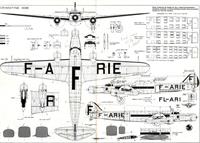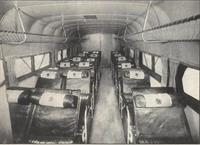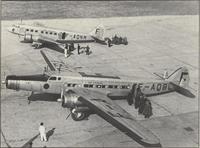In 1934, Compagnie Aérienne SABENA (Société Anonyme Belge d'Exploitation de la Navigation Aérienne), ordered from the Dewoitine Company, an aircraft for its airlines in the Congo. Dewoitine responds with what should have been the D335B, which is an enlarged version of the D332. But following the accident of the latter in January 1934, the design of the new aircraft is reviewed: the structural strength of the aircraft is strengthened, and it becomes the D338. This redesign, however, led to significant delays for the project, and SABENA canceled its order. The assembly of the prototype is however too advanced for Dewoitine to abandon it, and the construction continues on private bottom with the hope to interest other airlines like Air France
The aircraft is an all-metal, low-wing, partially retractable monoplane: Wheels exceed nacelles to protect the cell in case of landing brought in train. It is powered by 3 9-cylinder, 9-cylinder, 650-hp Hispano-Suiza 9V air-cooled engines on take-off, with in variable pitch, two-blade metal propellers. The fuselage is of rectangular section allowing to accueuillir 3 passengers in front. The crew consists of 3 people, two pilots, and a radio, with the addition of a mechanic for long haul trips. The total number of passengers varies according to flights: 22 passengers for European flights, 15 on Toulouse-Dakar routes, and 8 to 12 passengers on Far East routes (2000 kms). The unit had a certain comfort with a good soundproofing and efficient heating.
The prototype, registered F-AOZA and nicknamed "Clémence Isaure", made its first flight on August 9, 1935. Soon, problems of longitudinal instability appear and different aerodynamic configurations are tested in the wind tunnel before finding a compromise, the main modifications concerning empennages and wing fittings.
As Dewoitine hoped, Air France was indeed interested in the aircraft and first bought the prototype in May 1936, before placing several orders for another 28 D338s. The last copy delivered was the F-ARIH, "city of Karachi", taken into account by Air France on July 18, 1939. The Air Force also ordered 10 aircraft, but only two aircraft will be delivered (Registration Nr. 244 and R-245). A total of 31 D 338 were built, including the prototype.
The prototype made the first commercial laison on the Paris-Lyon-Marseille line on July 13, 1936. At the end of 1937, Air France had 4 Dewoitine D338 and 16 at the end of August 1938.
In January 1938, the D.338 No. 1 F-AQBA opened the France-Indochina link with a Marseilles-Hanoi flight, extended in August to Hong Kong by the D.338 No. 6 F-AQBF.
At the end of 1938, a Tunis, Tripoli, Benghazi, Cairo, Lydda and Beirut link was set up. In the summer of 1939, 9 D.338 will provide a weekly liaison.
These first flights confirmed the lack of longitudinal stability, this defect being mainly related to the flat rectangular section of the fuselage. The D.338 # 11 F-AQBK received 2 small fins on the extrados of the fixed stabilizer and the fins are reinforced. These evolutions will be integrated on the following aircraft.
In March 1939, the D-338 No. 18 F-AQBR and No. 20 F-AQBT went to Argentina to replace the D.333 No. 1 F-ANQB "Cassiopée" and No. 2 F-ANQC "Altaïr" assigned on the Natal-Buenos Aires line. At the Armistice, the Argentine authorities, pushed by the United States, seize the D.333 and D.338 which are stored on the spot. The two D.338 will be sold at the end of 1943 to the Air Force Argentina, and under the numbers the numbers T-170 and T-171, they integrate the 2nd Transport Regiment, based in El Palomar, near Buenos Aires. . They will remain in service probably until 1946, 1947.
At the declaration of war, the Air Force requisitioned a dozen D.338 Air France, to equip 5 Sections Long-Haul Airplane (SALC), each section is composed of 3 devices. lack of practical use, many of them will quickly resume their commercial flights. After the Armistice, the Germans allowed Air France to continue its commercial flights; From May to July 1941, during the Syria campaign against the Allied forces, 18 D 338 of Air France, with their civilian crews are again requisitioned by the Vichy Air Force to reinforce the WG II / 15 (Transport Group). They will establish an air bridge between Metropolitan France and Syria, to transport men and equipment day and night. Three D.338s will be destroyed by Allied air strikes, and three more will be seized by the Free French Air Force.
On February 1, 1943, Lufthansa signed a lease agreement covering 8 D-338. The Germans, skeptical about the flying qualities of Dewoitine 338, wanted to perform performance flights. It is the No. 13 D-AYWT (then D-AUAN by Lufthansa) which is conveyed to Berlin on April 14, 1943 to be presented in flight. The French pilots make an unconvincing demonstration on May 29, 1943 to dissuade the Germans from using Dewoitine. Air France will never recover its aircrafts.



In the German occupation of southern France in November 1942 there were only eight D.338. The rest flew in North Africa and thus came into the access of the Allies. Since the German Lufthansa suffered from a significant aircraft shortage, after a large part of the fleet at the beginning of the war had to be handed over to the Air Force, they had to charter aircraft from other companies. Interesting for them in this case were the Dewoitine 338 and the Bloch MB.220. Accordingly, the available eight D.338 were chartered on 1 February 1943 . The F-AQBM received the German transfer license D-AYWT and was flown on 16 April 1943 to Berlin. With the new registration D-AUAN test flights were made, but where a certain instability of the aircraft was detected. Therefore, it was decided that the aircraft had to be modified before being used in air traffic. In October 1943, three more D.338s were transferred to Berlin to make these changes. But that did not happen any more, as the Ju 52 could be obtained from the Luftwaffe series. The four delivered aircraft were not used and later destroyed by war events. The remaining four chartered aircraft remained in Toulouse-Montaudron, where two were destroyed on 2 May 1944 by a bomb attack. The D.338 was used only once in the regular service of the DLH in the fourth quarter of 1943 with 524 kilometers of air .
| Type |
Airliner 4 + 12/15/18/22 depending on route |
| Engine |
3 Hispano-Suiza 9V-16 / Hispano-Suiza 9V-17 |
| Dimensions |
Length 22,13 m , height 5,57 m , span 29,0 m , wing area 80 m2 , |
| Weights |
Empty , loaded 7905 kg , max. take off weight 11150 kg |
| Performance |
Max.. speed 301 km/h , cruising speed 260 km/h , range 1950 km, endurance , service ceiling 4900 m , climb 30 min. 34 sec. to 4000 m |
| Type |
Werk.Nr |
Registration |
History |
|
3 |
F-AQBC, D-ASBP, D-AYWR
D-AUAM |
Aîrcraft delivered to Air France. It was based in Paris and is named "Mlle de Lyon". It was requisitionned by the Air Force. In February 1943, it is part of the D338:s sent to Germanv for use bv Lufthansa. |
|
13 |
F-AQBM, D-AYWT, D-AUAN
|
Aircraft delivered to Air France. It was based in Paris and nicknamed "Ille de Reims". Requisitioned by the Air Force, it was donated to Air France afterwards. On February 1. 1943, Lufthansa signed a lease agreement for 8 D-338s. The Germans, skeptical about the flyîng qualities of the Dewoitine 338.wanted to test it. AYWT which was flown to Berlin on April 14, 1943 to be shown in flight. The French pilots made an unconvincing démonstration on May 29, 1943 to dissuade the Germans from using the Dewoitine. . |
|
17 |
F-AQBQ, D-AUAU |
Aircraft delivered to Air France. It was based in Toulouse and nicknamed "Ville de Tours". It was requisitioned by the Air Force. In February 1943. it was one of the D338:s sent to Germany for use by Lufthansa. It was not used much under the German colors and its trace disappears. |
|
28 |
FARIF, D-AZAT
|
Aircraft delivered to Air France. It was based in Paris and named "Mlle de Bordeaux". Requisitioned by the Air Force, it participated in the Campaign of the Levant in 1941. On July 13. 1940, it escaped from the Aleppo so as not to fall into the hands of Free French and landed in Athens. The Germans blocked it a time in Athens before allowing it to fly to Istres. In February 1943, it was part of the D338:s sent to Germany for use by Lufthansa. It was not used much under the German colors and its trace disappears. |
